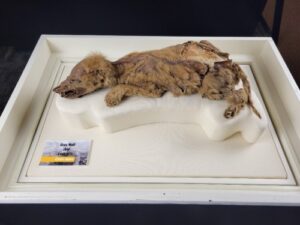 Adventures of the prehistoric kind don’t come better than this. Following an extensive refurbishment, the world-class Yukon Beringia Interpretive Centre re-opened in the capital city of Whitehorse, Yukon Territory, in Canada’s north-west. This lively Ice Age savannah now features new fossils, murals, displays and interactive experiences, telling the story of the Yukon’s incredible Ice Age history. Read on to unearth rare ancient relics and fascinating fossils.
Adventures of the prehistoric kind don’t come better than this. Following an extensive refurbishment, the world-class Yukon Beringia Interpretive Centre re-opened in the capital city of Whitehorse, Yukon Territory, in Canada’s north-west. This lively Ice Age savannah now features new fossils, murals, displays and interactive experiences, telling the story of the Yukon’s incredible Ice Age history. Read on to unearth rare ancient relics and fascinating fossils.
Beringia was a land bridge that once linked Alaska and Siberia, providing a route for humans and animals to migrate into North America tens of thousands of years ago. Visitors to the Beringia Centre can step back tens of thousands of years as they witness a 1.5-million-year-old caribou bone, the oldest in the Arctic, as well as the only fossil whitefish in the world. Meet Zhùr (meaning wolf), an ancient mummified wolf pup discovered in the permafrost in 2016 by Yukon miners working in the Klondike goldfields near Dawson City. This tiny wolf pup is the best preserved and most complete mummy of an ancient wolf found to date. The scientific team worked with the Tr’ondëk Hwëch’in to highlight the cultural importance of wolves and other ice age mammals within their community.
Marvel at the Yukon Horse display containing 26,000-year-old remains and learn about the First People who crossed the Beringia land bridge. Check out the life-like dioramas of a scimitar cat and giant short-faced bear, and marvel at the mummified arctic ground squirrel and Yukon caribou.
The Beringia Centre showcases a stunning replica of the famous Bluefish Caves archaeological site, where the jawbone of an ancient Yukon horse was discovered, believed to be around 24,000 years old. Consisting of three caves, located near the Old Crow community, the first contained various animal bones that were dragged there by predators, as well as tools that indicate a human presence. The Centre also features films, guided tours, original works of art, and exhibits of discovered remains from throughout the Yukon, all contributing to a better understanding of the long lost sub-continent of Beringia.

Through collaboration between the Yukon Palaeontology Program, local miners and First Nations, more treasures of the Yukon’s distant past are being recovered every year, telling the story of a world quite unlike the Yukon you see today.
Extremely well-preserved remains found frozen in permafrost provide remarkable insights into the genetic makeup, appearance, and diet of these iconic animals. Woolly mammoths disappeared from Yukon around 12,000 years ago, at the end of the last glacial period. However, an isolated population managed to survive on an island off the northern coast of Siberia until as recently as 4,000 years ago.
The Yukon is a renowned global leader for ice age and Beringia research, but the story of how many of these remains were found is as fascinating as the fossils themselves. When the Klondike Gold Rush brought miners to the Yukon, stories of giant beasts unearthed began to spread. More mummified creatures are likely to be found in the years ahead, preserved in the permafrost, as miners continue to dig for gold.
Getting there: Air Canada offers daily direct flights to Vancouver from Sydney and Brisbane. Direct flights from Sydney to Vancouver are also available on Qantas. Internal flights to Whitehorse and Dawson City are available on Air North and Air Canada. More information, visit travelyukon.com




















